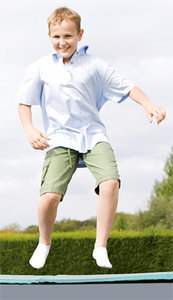Gary Smith, chairman of the AAP Committee on Injury, Violence and Poison Prevention and former director of emergency medicine at Children's Hospital of Columbus, has been a longtime supporter of a complete ban on home trampolines. In 1998, he stated, "We've seen the number of trampoline-related injuries skyrocket in just six years, and the trend doesn't show any signs of slowing down. Instead, it's continuing to increase." His research showed the injuries sustained during trampoline use were enough to support a ban:
- The number of injuries increased by 98 percent during a six-year study.
- Younger children tended to have injuries to their arms, the majority of which were fractures or dislocations.
- Younger children also had a higher rate of facial injuries - most often lacerations.
- Older children commonly sustained injuries to their legs - bruises, sprains, strains and contusions.
- Approximately 3 percent of all injuries required hospitalization.
- Twelve percent of the injuries to young children and 7 percent of injuries to older children were to the head and neck.
Smith also stated that while most of the injuries sustained were to the children's extremities, there have been reports of death and severe injuries to the spinal cord, "which usually lead to paralysis and quadriplegia."
 "It's alarming that these injuries are increasing at a rate that is rare to see for any other product out on the market," Smith said. "This is a public-health problem that needs to be addressed with stronger strategies than those currently in place."
"It's alarming that these injuries are increasing at a rate that is rare to see for any other product out on the market," Smith said. "This is a public-health problem that needs to be addressed with stronger strategies than those currently in place."
Surprisingly enough, more than twice as many trampoline-related injuries are treated in hospital ERs annually compared to baby walker injuries. There is a virtual consensus on the need to ban baby walkers, while trampolines - clearly the more dangerous item - are still being sold for home use.
In a 2005 article in USA Today, Smith's message remained the same: "Where we have gone wrong is that [trampolines] have popped up in many backyards, and parents don't realize the danger involved. They're using them as toys without recognizing the hazards."
Many parents have taken the warnings to heart and have purchased safety nets to place around their trampoline. However, these safety measures do not correct the problem of the dangerously large gaps between the springs or stop more than one child from being on the trampoline at a time. History proves the only way to truly keep children safe from a trampoline is to not let them on one.
I encourage you to recognize the potential serious injuries related to the use of the trampoline and prohibit your children from using them. If you continue to allow your child to play on a trampoline, beware of the possible minor injuries that may occur to their developing spine. This includes upper neck trauma, sacral (tailbone) injury (similar to repetitive-stress syndrome) and flexion-extension injury to the lumbar spine. Should your child complain of any spine or muscle (close to their spine) pains or aches, contact your chiropractor to perform a thorough exam.
Claudia Anrig, DC, practices in Fresno, Calif., and is on the board of directors of the International Chiropractic Pediatric Association, an organization that can answer your questions regarding the value of chiropractic care during and after pregnancy.

